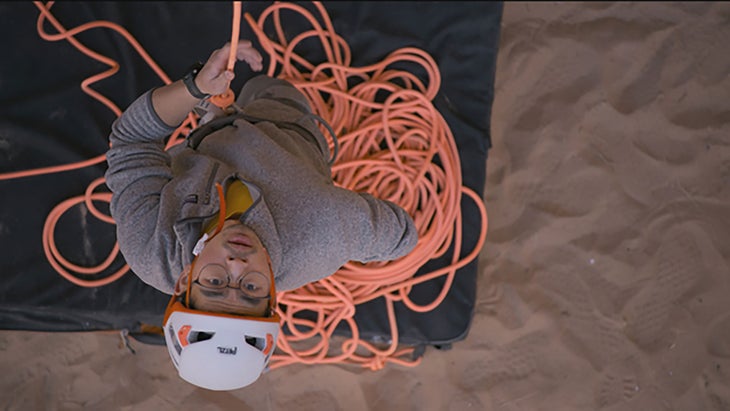
Twenty-four-year-old Cat Runner of Louisville, Kentucky, waved warmly to a full house—and a standing ovation—at Colorado’s Boulder Theater on the night of Thursday, January 26 following the airing of the finale of HBO’s rock climbing reality show The Climb. The eight-episode series featured ten climbers vying for a $100,000 grand prize plus a one-year sponsorship from PrAna, also worth $100,000.
The show, which was produced by climbing veteran Chris Sharma and Hollywood star Jason Mamoa (yes, Aquaman), cast competitors who climb routes rated between 5.11 to 5.12 or V4 to V6 (considered intermediate-level climbs). Producers cast amateur climbers rather than professional or top-level ones in an effort to make the show relatable to experts and casual fans of the sport.
The morning after the event, Runner, who is 24, met me for breakfast in Boulder. “I love breaking beta—it’s the most fun,” Runner told me. In climbing parlance, the phrase refers to finding a new method for climbing a route—oftentimes one that is easier or more straightforward. Runner, who stands just five feet tall, was referring to being what he calls “an extremely short climber who often can’t do the classic beta of a route.” Instead of relying on a long reach, Runner must find ways to move up a route that work for him and his relatively short limbs. It’s this kind of problem-solving that Runner had to tap into on the reality show’s final two climbs—a 7c/5.12d and 8a/5.13b—to beat runner-up Dominic “Dom” Terrill Berry, who is much taller. Both of the routes Runner climbed—called Ejector Seat and All Cats are Black in the Night—soar over the Mediterranean Sea on Mallorca’s Diablo Wall. The area was made famous by Sharma, and both ascents span 60 feet up orange limestone over the water.
Runner says he’s also broken beta on a route (12a) at his home crag in Kentucky’s Red River Gorge that he says is “known for spewing off short climbers.”
But Runner has been breaking the beta of life, so to speak, since coming out as a transgender man when he was a teenager.
“I didn’t realize until that night, once we had done filming, that I won on the anniversary of my top surgery,” Runner told me between sips of tea. “So it was very special.” Top surgery, also called masculinizing chest surgery, is a procedure to remove breast tissue that Runner underwent in 2014. “That was the most pivotal moment of my transition,” he said.

BASKETBALL, BOWLING, AND POLICY
Climbing is a major source of joy in Runner’s life, and he says the sport’s physical and mental connection—attaining the so-called “flow state”—instills a feeling of trust in him.
“You’re giving your entire self to just listening to your body and letting it do its thing. And then your body and your mind are finally talking to each other at the same wavelength,” he says. “And they’re not conflicting with each other. They are just one thing, and it’s peaceful.”
He began pursuing the sport in earnest later in high school after playing team sports as a kid. Runner grew up in Louisville, Kentucky, with his adoptive parents and played basketball and field hockey during seventh and eighth grades. Knee pain from Osgood-Schlatter disease, common among growing adolescents, forced a break from team sports. Around the same time, Runner says he was going through what he calls “the whole gender thing.”
Runner transferred from a larger high school to a smaller, independent one after his sophomore year, which he says gave him more time to transition socially and begin his medical transition. Once he felt more comfortable in his body, he says, he wanted to pursue sports again because he missed it. “I was always athletic and moving growing up,” he says. But returning to basketball had its challenges, since Runner was still wearing a binder—a compression undergarment worn to flatten breasts. “[Basketball is] really hard cardiovascular intensity with breathing and I was like, ‘I want to be safe. I’m gonna bowl,” he said.
Runner, with the backing of his school, was going to bowl on the boys’ team. He’d started testosterone and had his top surgery scheduled. But the day of the first practice, the school’s athletic director told him that the Kentucky High School Athletic Association policies forbid his participation. His options: practice with boys and compete with girls, practice and compete with girls, or not compete at all.
“At that time in my transition, my identity was still fragile… So I just didn’t play,” he says. Rather than give up, the 16-year-old Runner decided to fight the state athletic association rules so he could play during his senior year. Runner took a deep dive in learning policy and rules that would have required him to have been on gender-affirming hormones for a year—“which in sports is a pretty common thing,” he says—and also undergo surgeries that would have resulted in sterilization. “For me, that would have been a hysterectomy or oophorectomy at 16, as well as bottom surgery, which would have meant some sort of phalloplasty or metoidioplasty,” explains Runner, “Both of which aren’t available in less than extreme emergencies. But you’re asking a teenager to do them to play a sport.”
Runner says he was frustrated and was tempted to prove a point by competing on the girls’ bowling team after having been on testosterone for a year. Ultimately, he decided not to pursue this action. “Looking back, it would not have been the best situation to do that. But the policies, which haven’t changed, are calling for things that aren’t available to someone that age,” he said. Policies like this, he says, create an unsafe reality for trans kids who want to play sports.
Runner did obtain special permission to play on the boys’ team his senior year with the support of his parents, the head of school, his counselor, doctor, and athletic director. But by the time he got clearance, which was midway through his senior year of high school, the demands of a busy senior year made it not possible. “I just didn’t have the time anymore and my life had to continue,” he says.
CONNECTING WITH CLIMBING
Runner has always loved to climb. “I grew up climbing trees and climbing everything,” Runner said. “I’m very good at mantles because that’s the only way to get to the top of things in the kitchen.” A mantle, in climbing, refers to what you’d do to hoist yourself up out of a pool: reaching up, pressing your palms flat, and levering your body upwards. Runner explains that this is how he would reach pancake mix or soup high in the pantry in his parent’s house when he was young.
Runner’s first introduction to rock climbing was at a youth program in the fourth and fifth grade, but it wasn’t until his senior year in high school—the year after he started testosterone, and had recovered from top surgery—that he reconnected with the sport. He started spending time at his home crag, the Red River Gorge in the Daniel Boone National Forest. Runner said that climbing gave him a feeling of peace.
“Figuring out how to navigate the world as this other person where I feel comfortable and confident and doing that in the climbing space, where I found myself as a climber—they merge together,” he says. “It’s very special. I never feel more at peace with myself and so grounded and aligned.”
Runner, who now works as a full-time as a commercial filmmaker and photographer, plans on using his new sponsorship and platform to grow the Queer Climber’s Network, an Instagram group he launched in 2022. Runner says the online community is focused on “connecting queer climbers and building a more-inclusive climbing community.” Though Runner is a self-described homebody, he says he’ll also take some climbing trips, and is ready to roll with whatever comes his way as the winner of the show and a newly sponsored climber.
“I’m just trying to remain flexible; I pride myself in my adaptability,” he says. “That is my greatest strength in climbing and in life.”
The post Cat Runner, Winner of ‘The Climb,’ Is Reaching New Heights appeared first on Outside Online.
by Fred Dreier via Outside Online
Comments